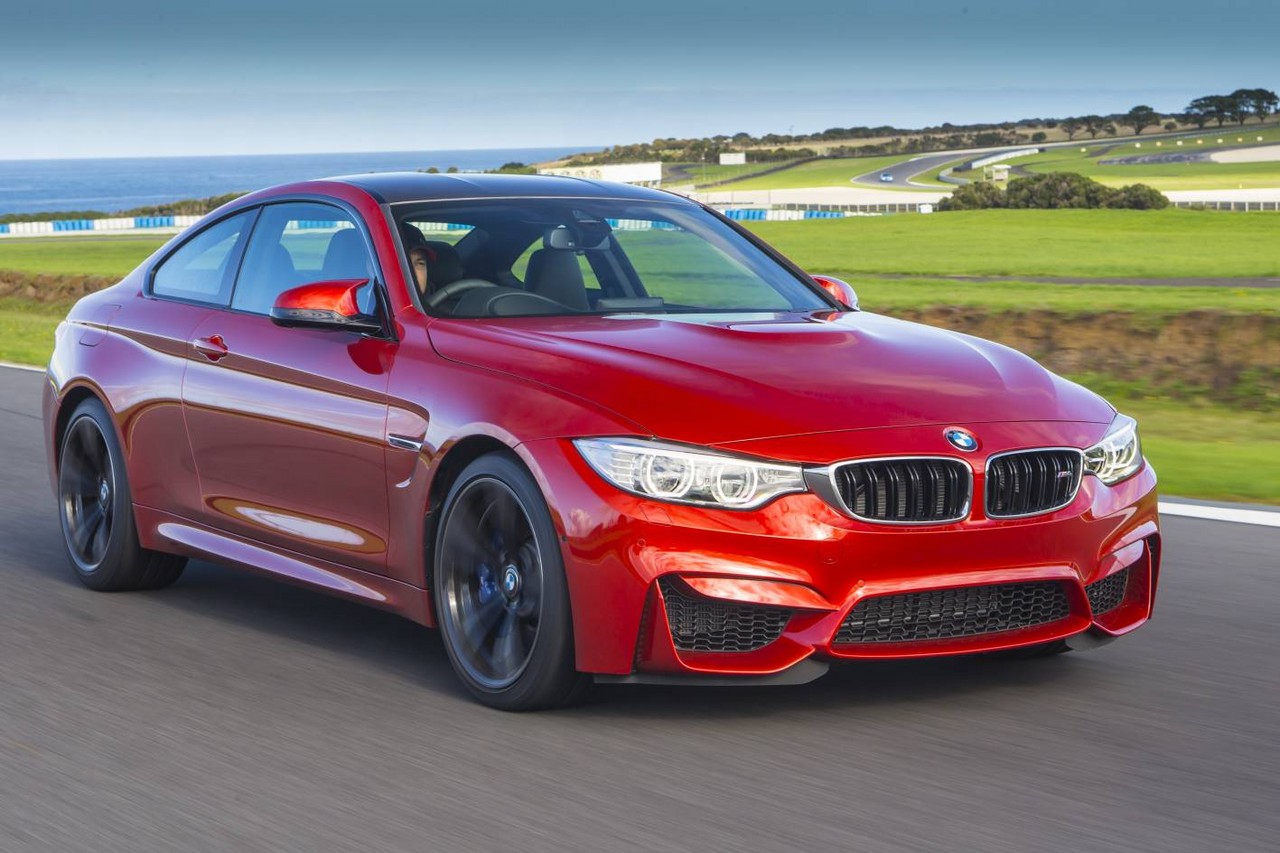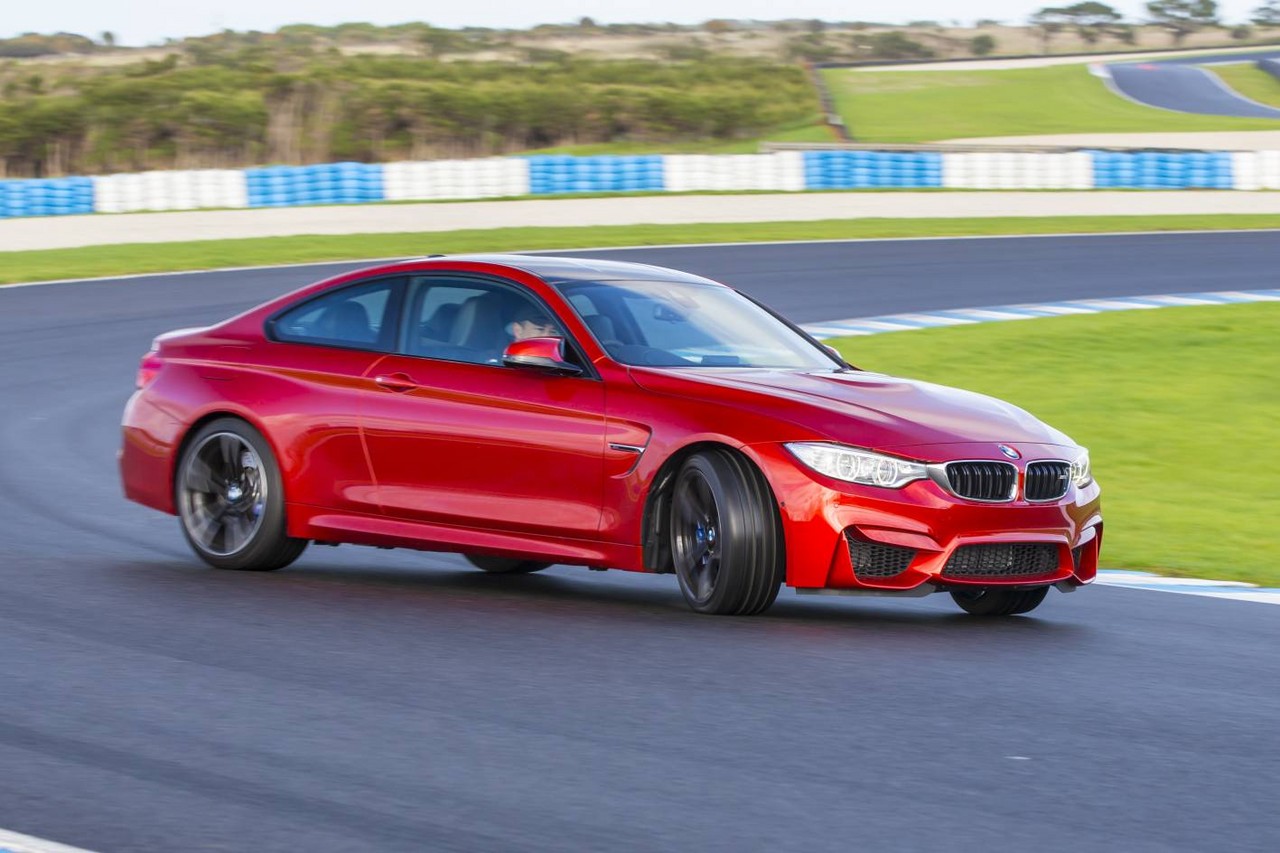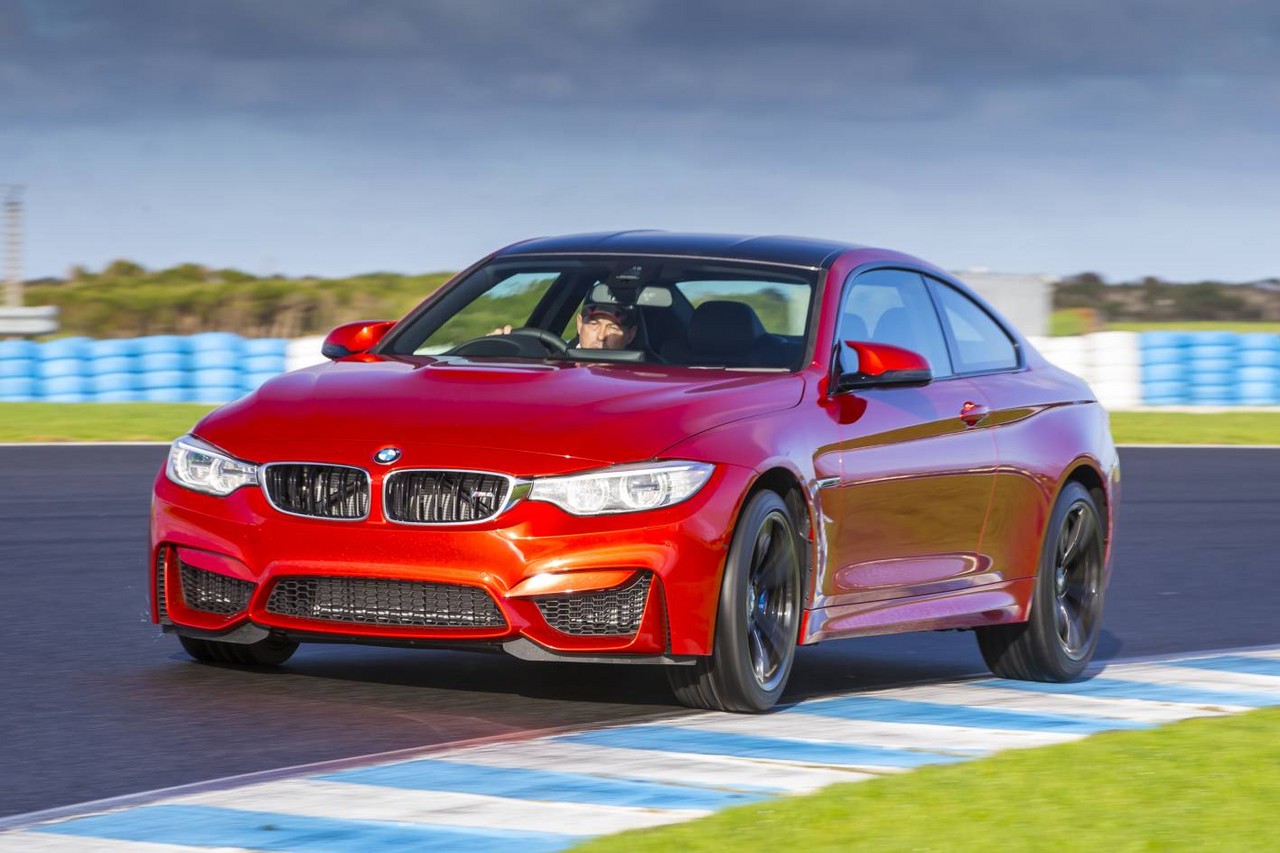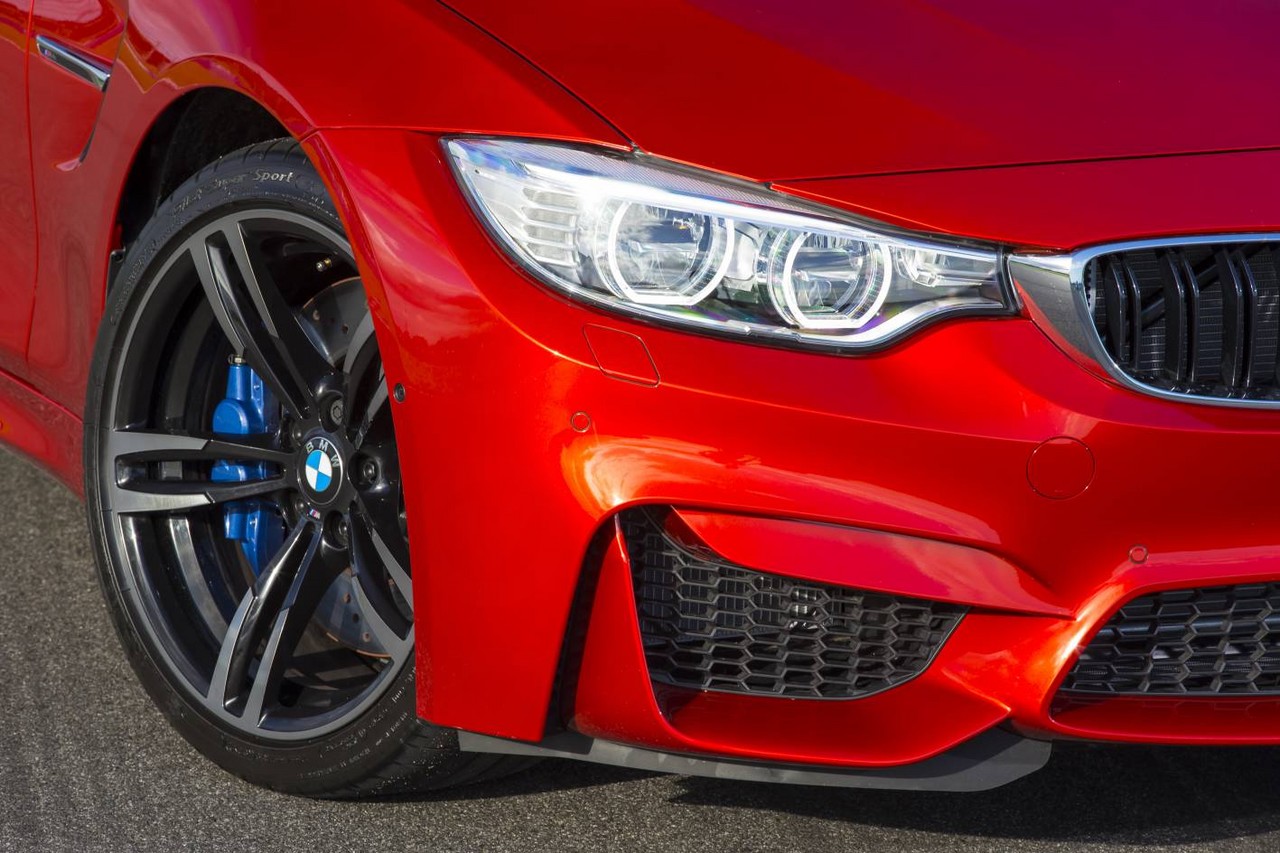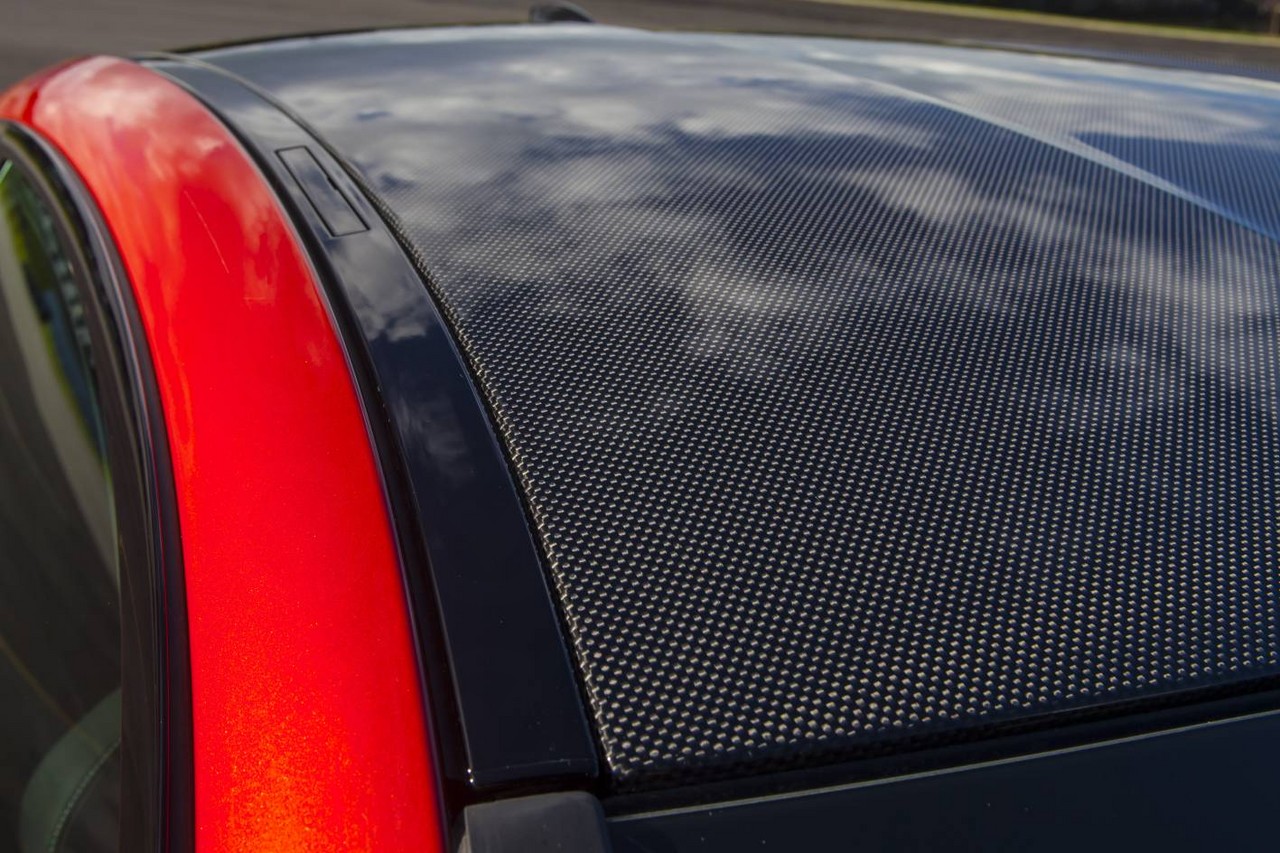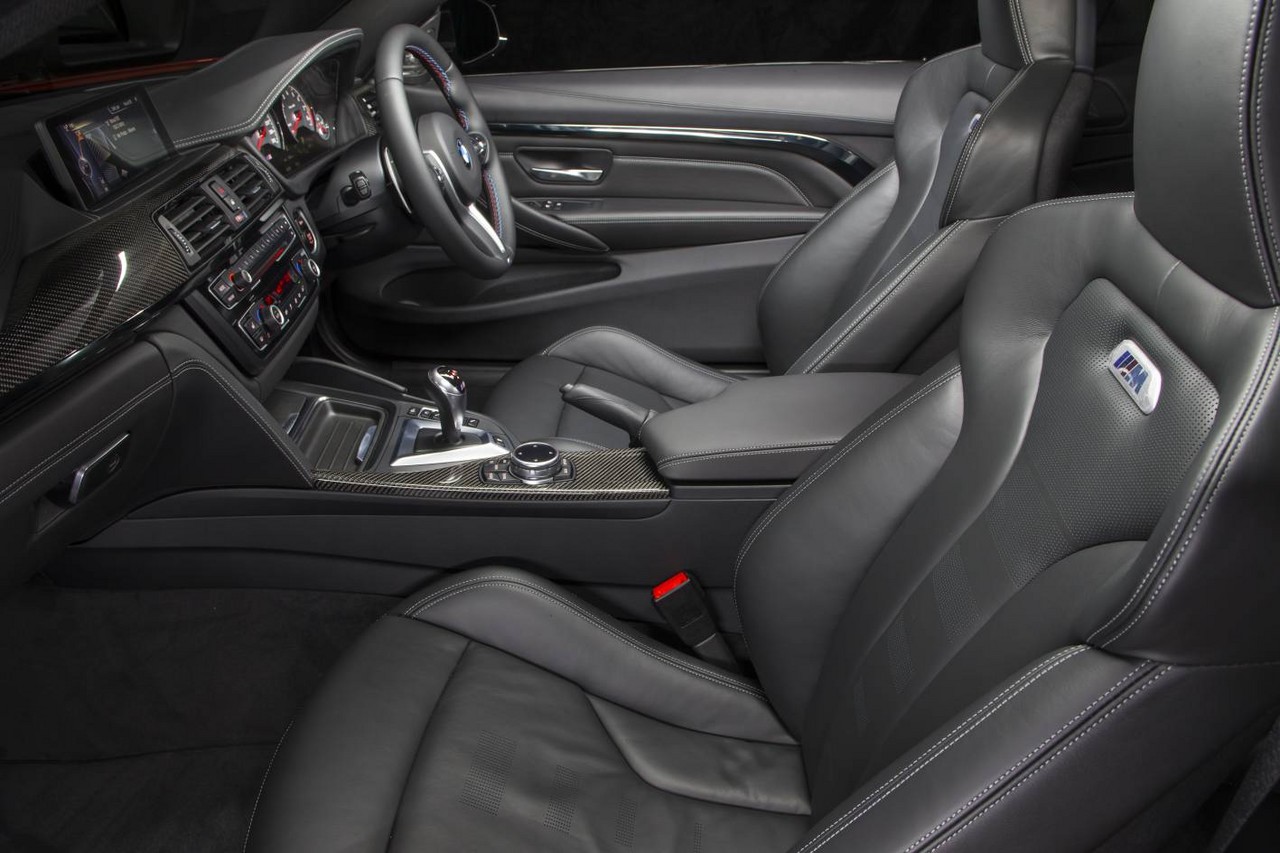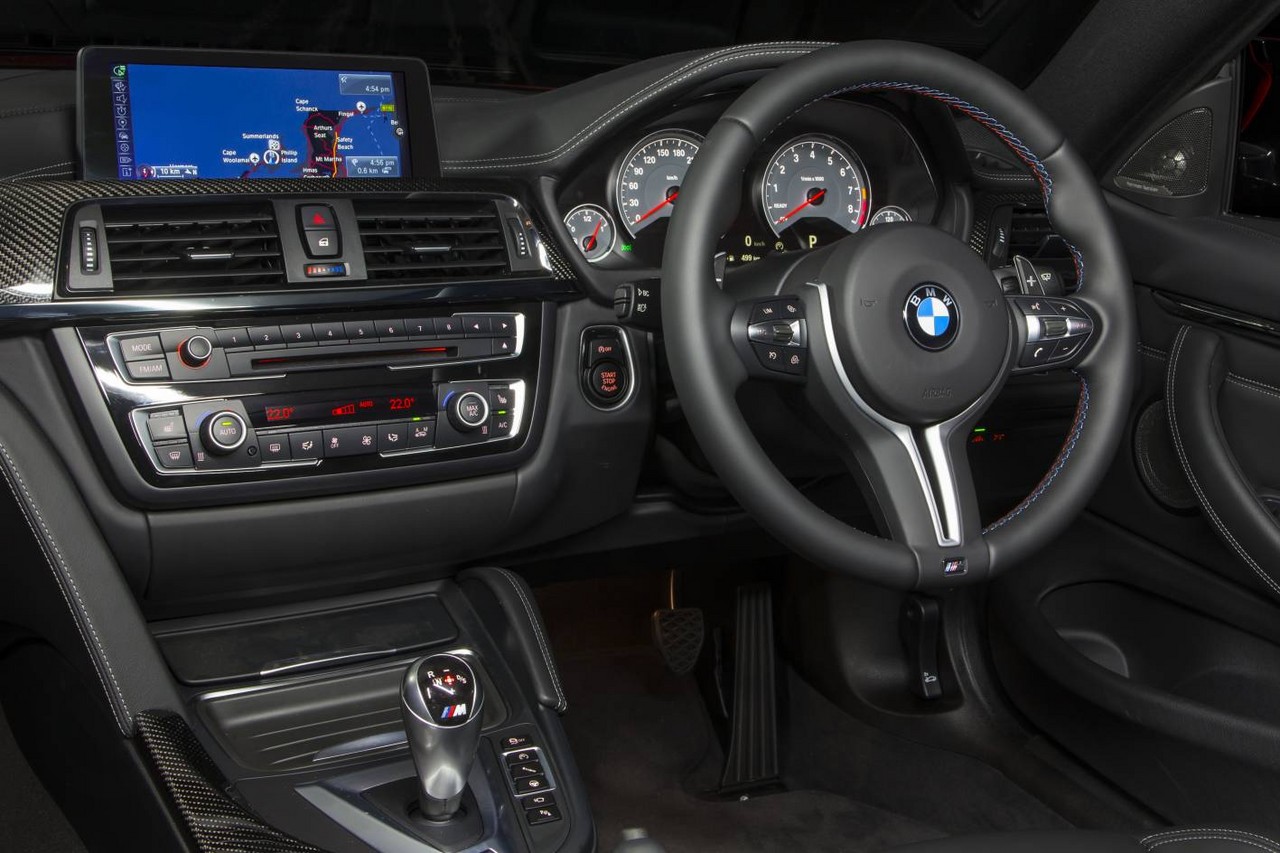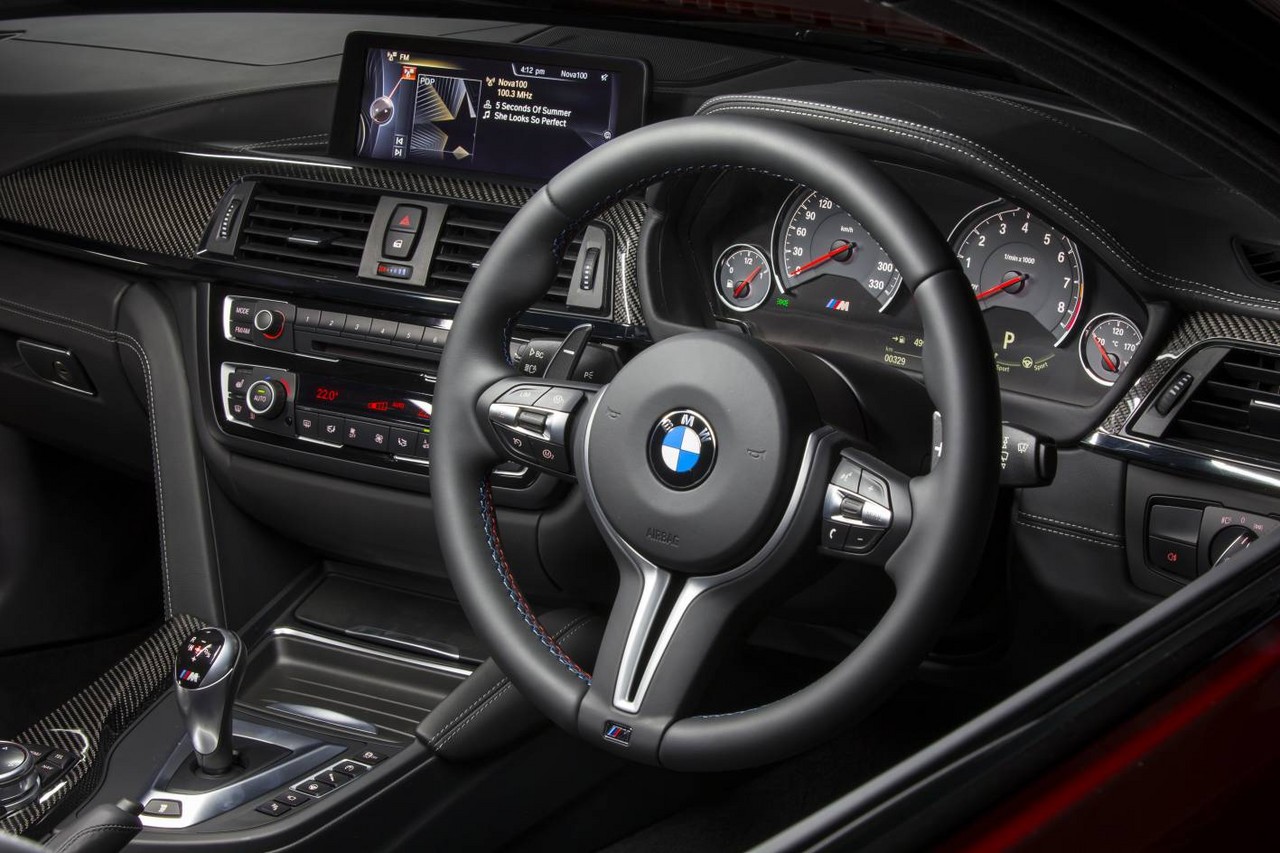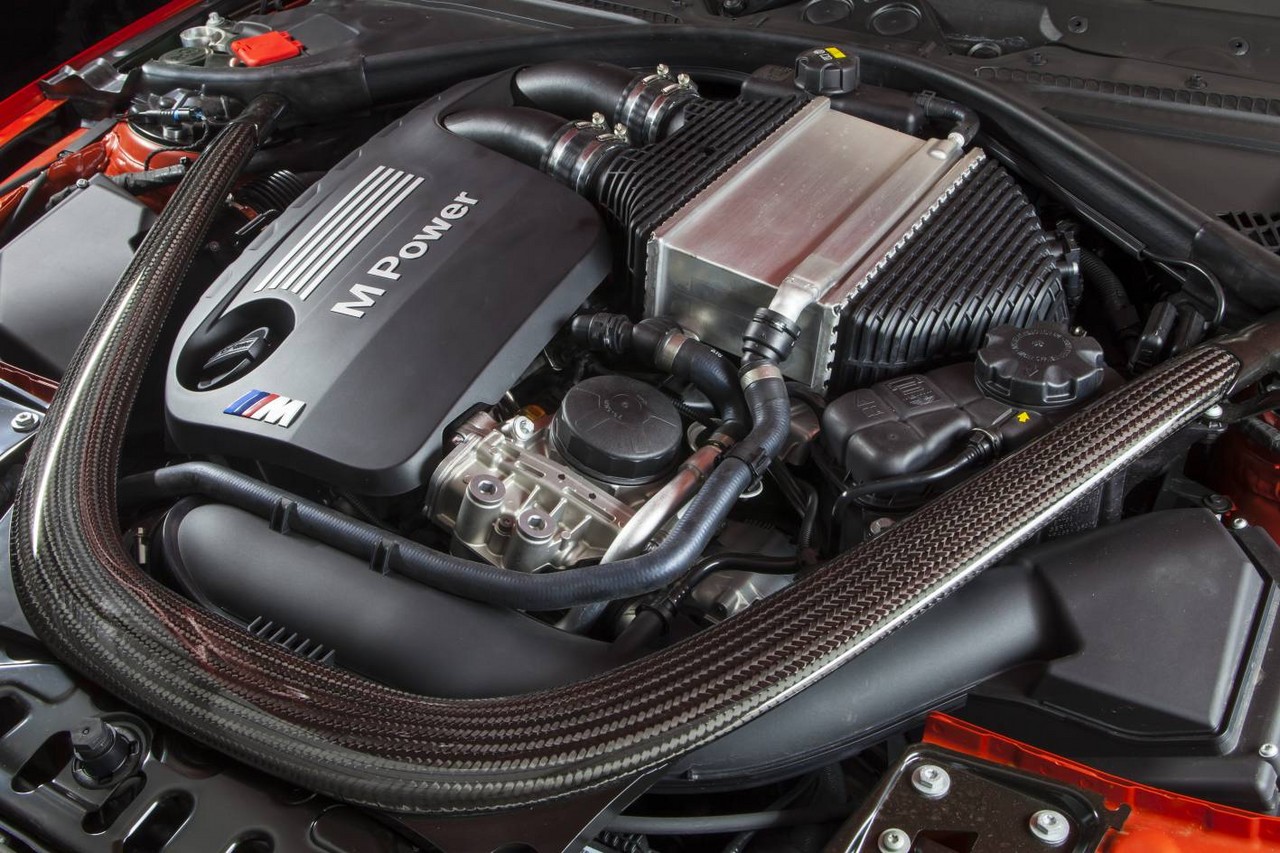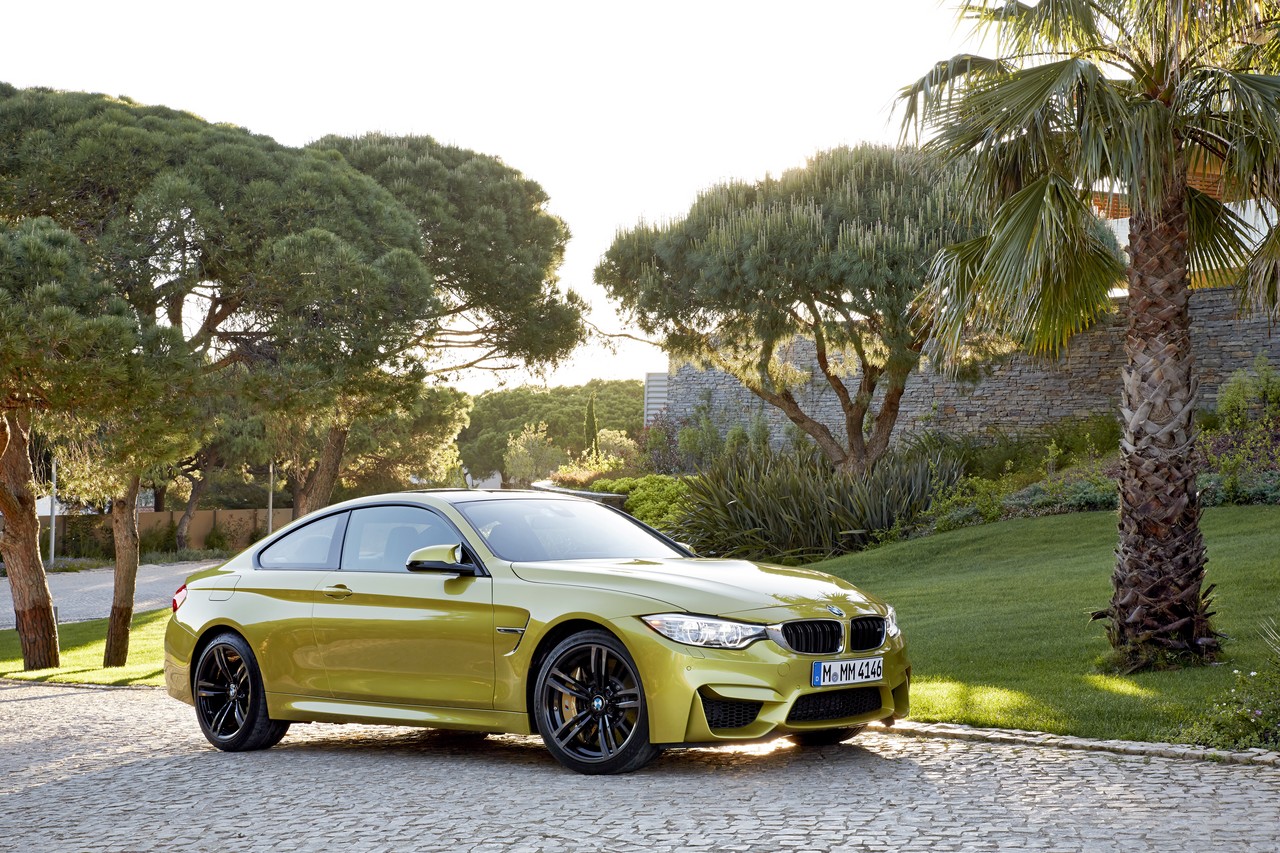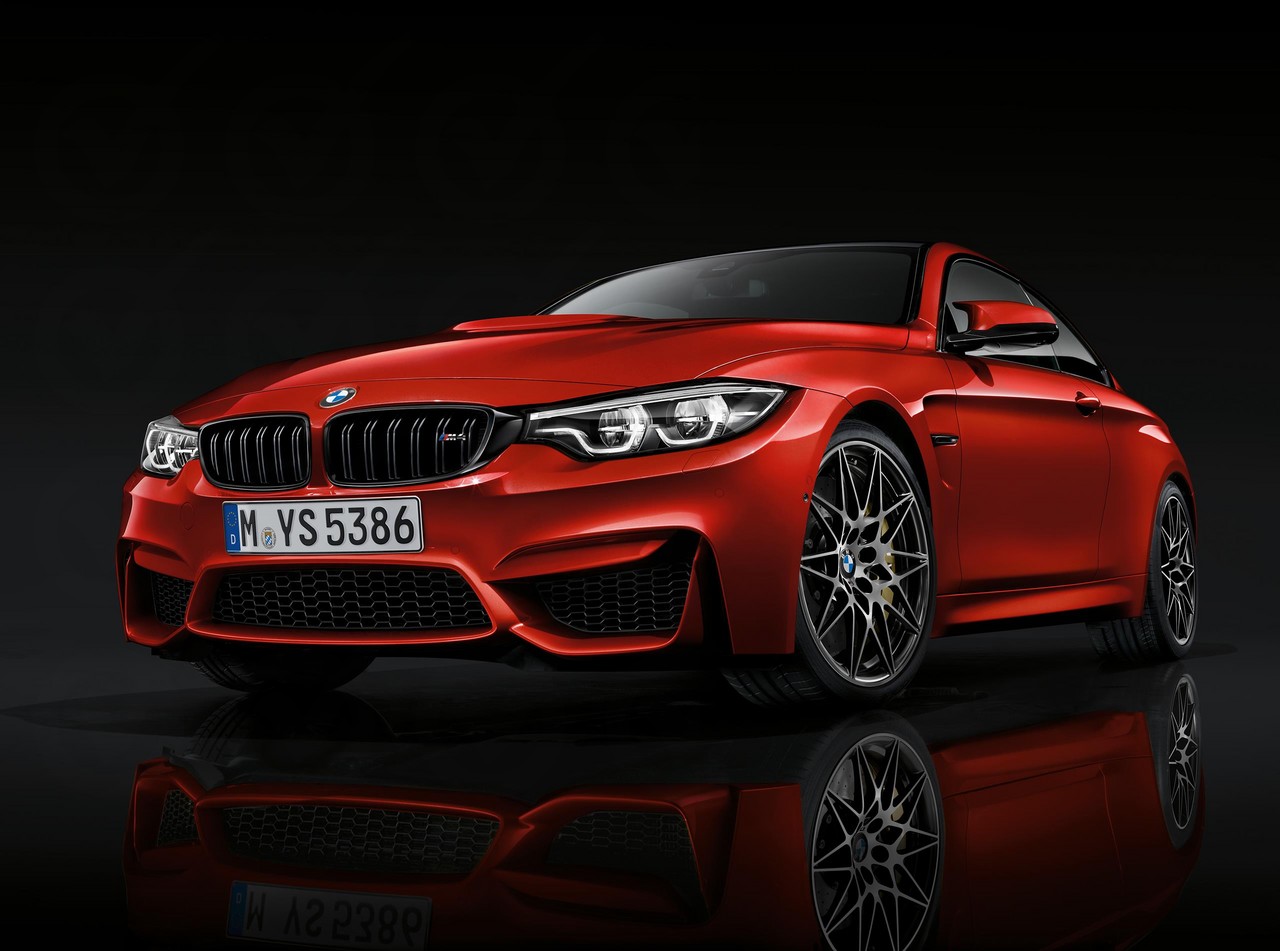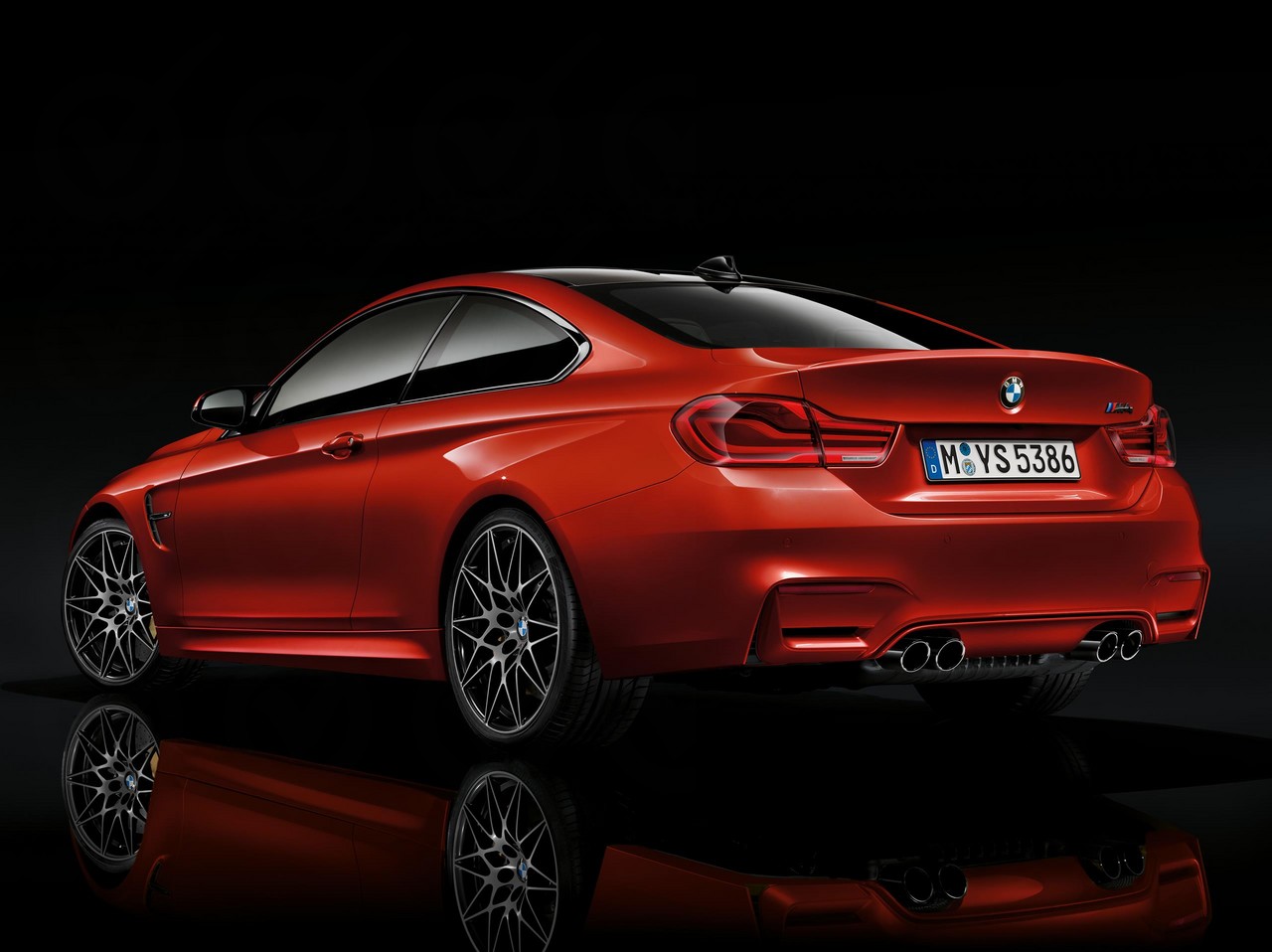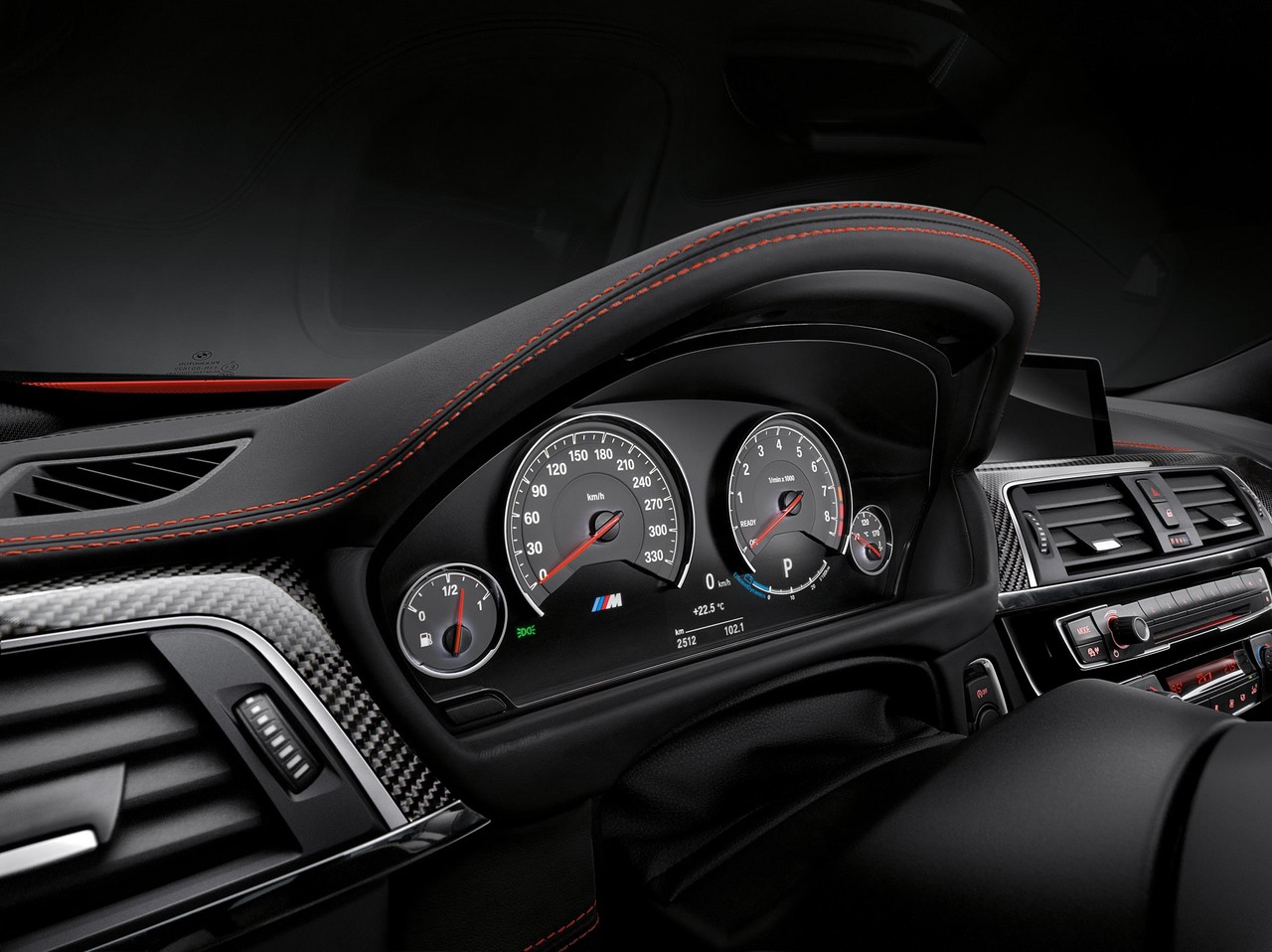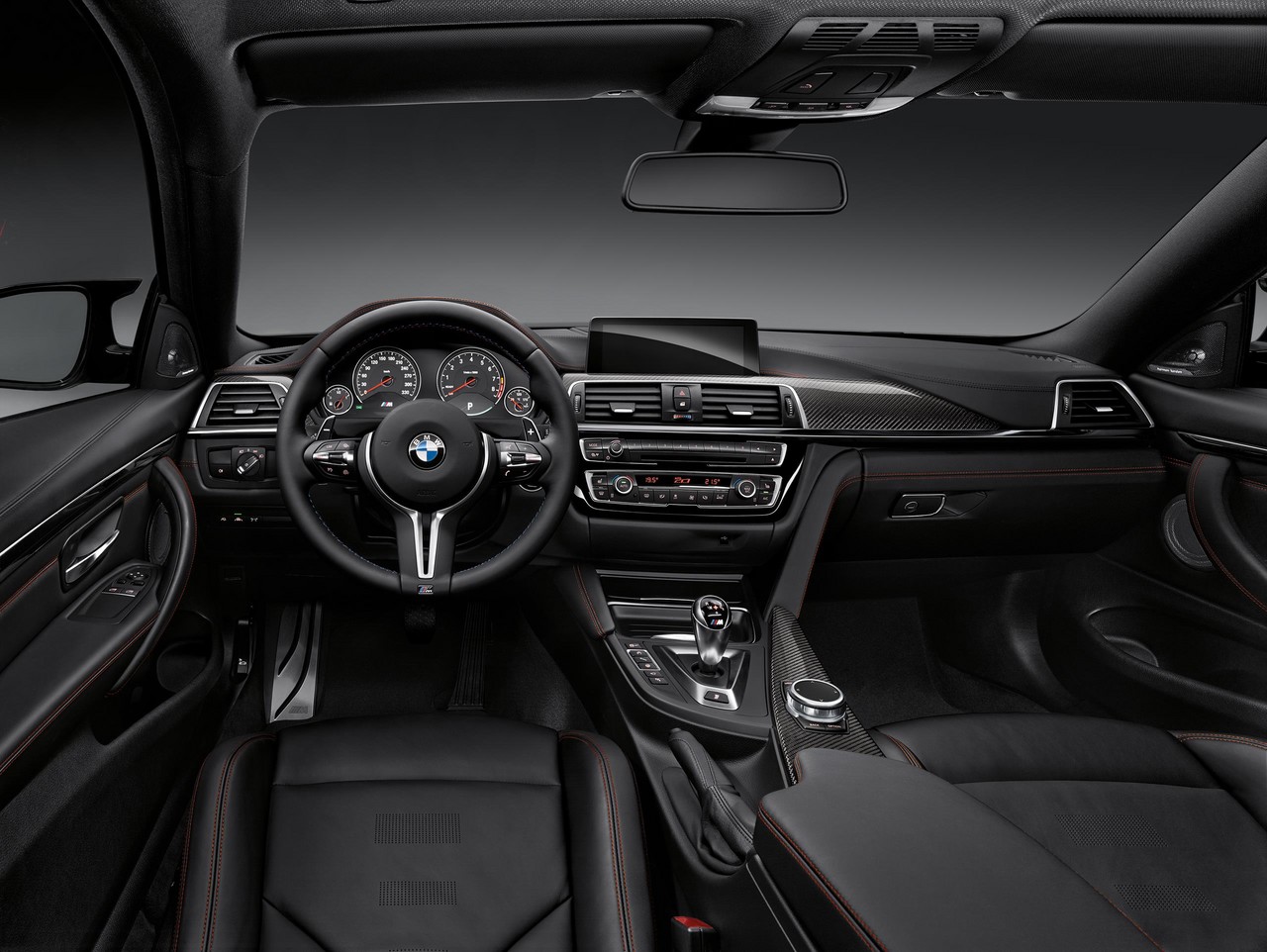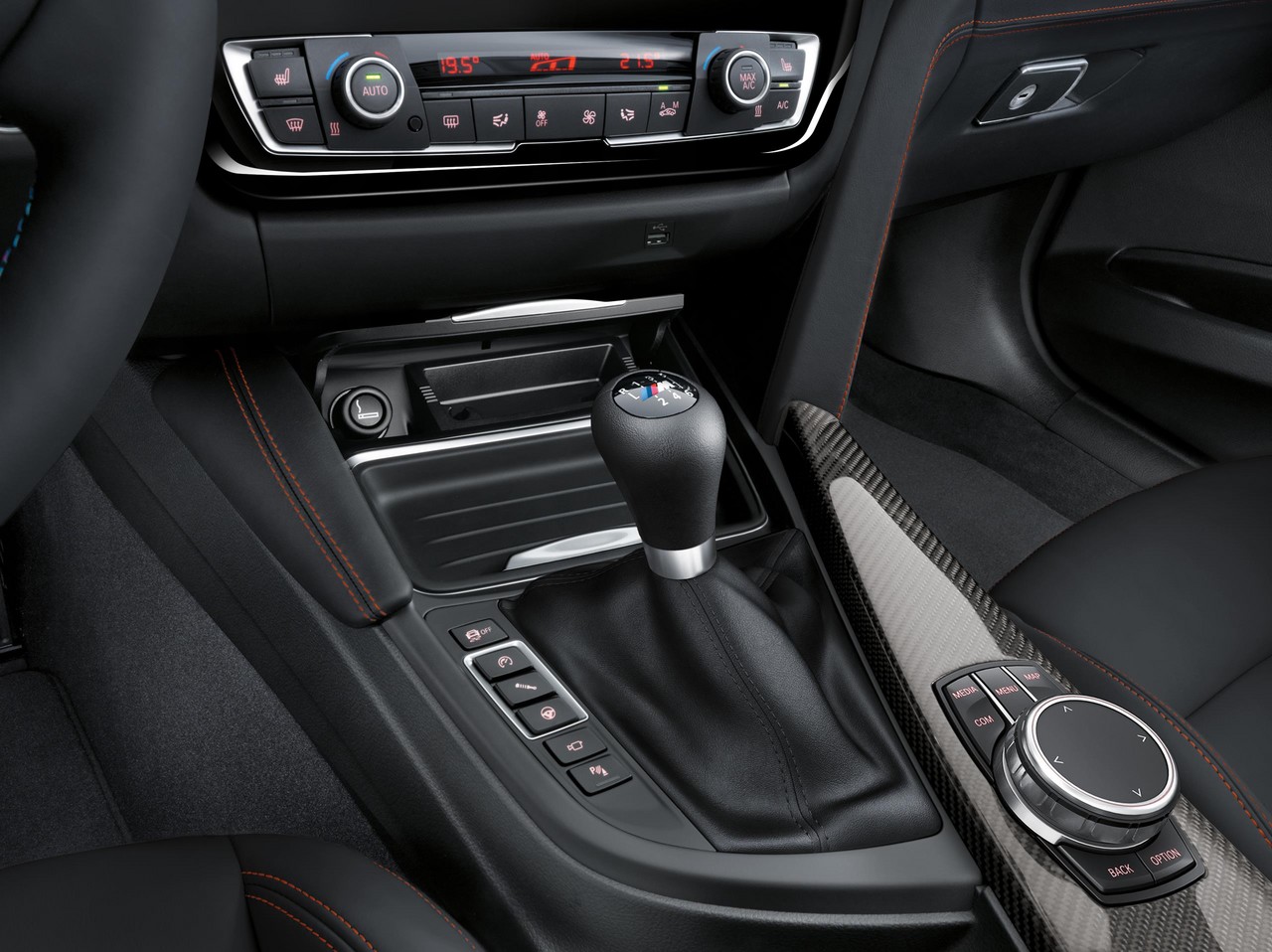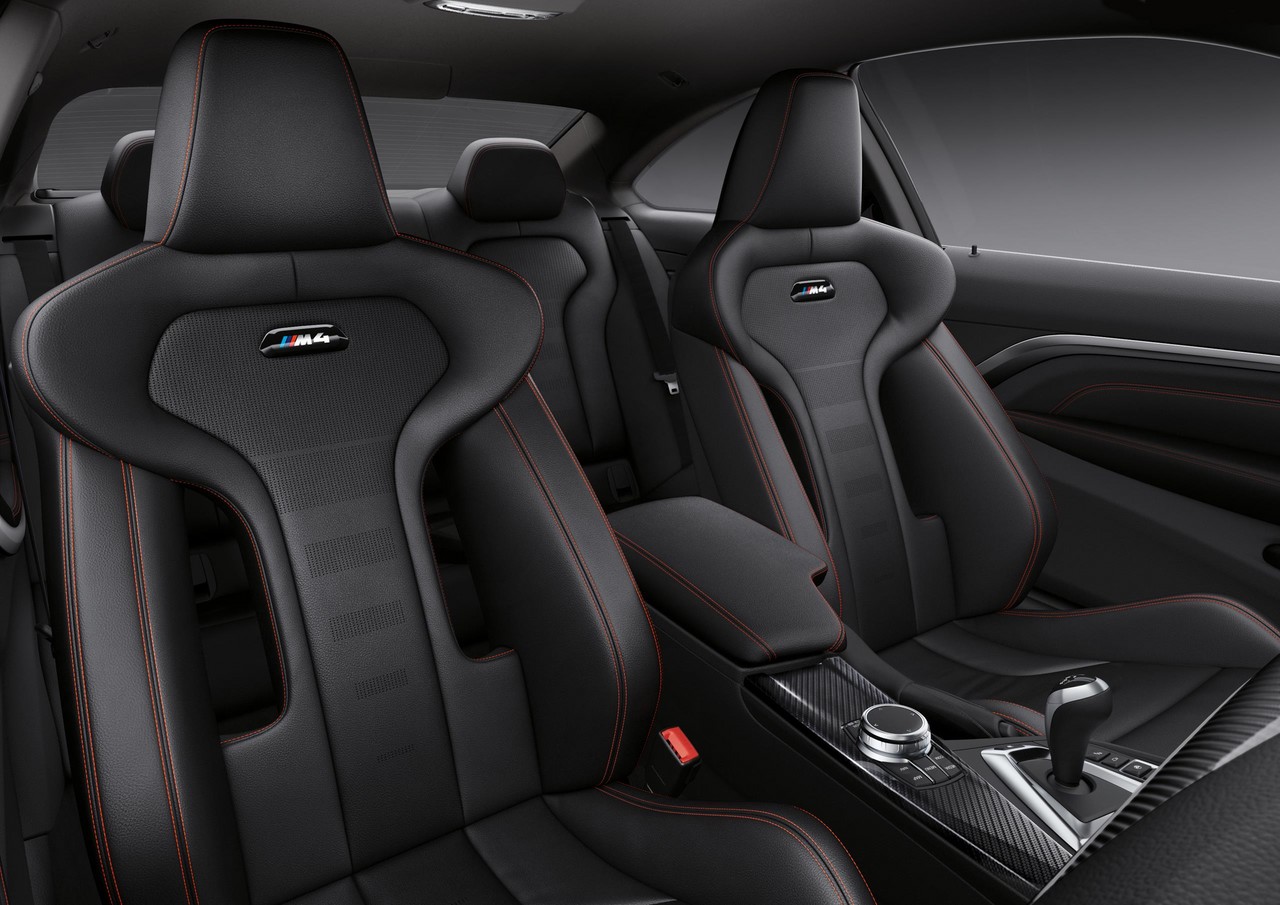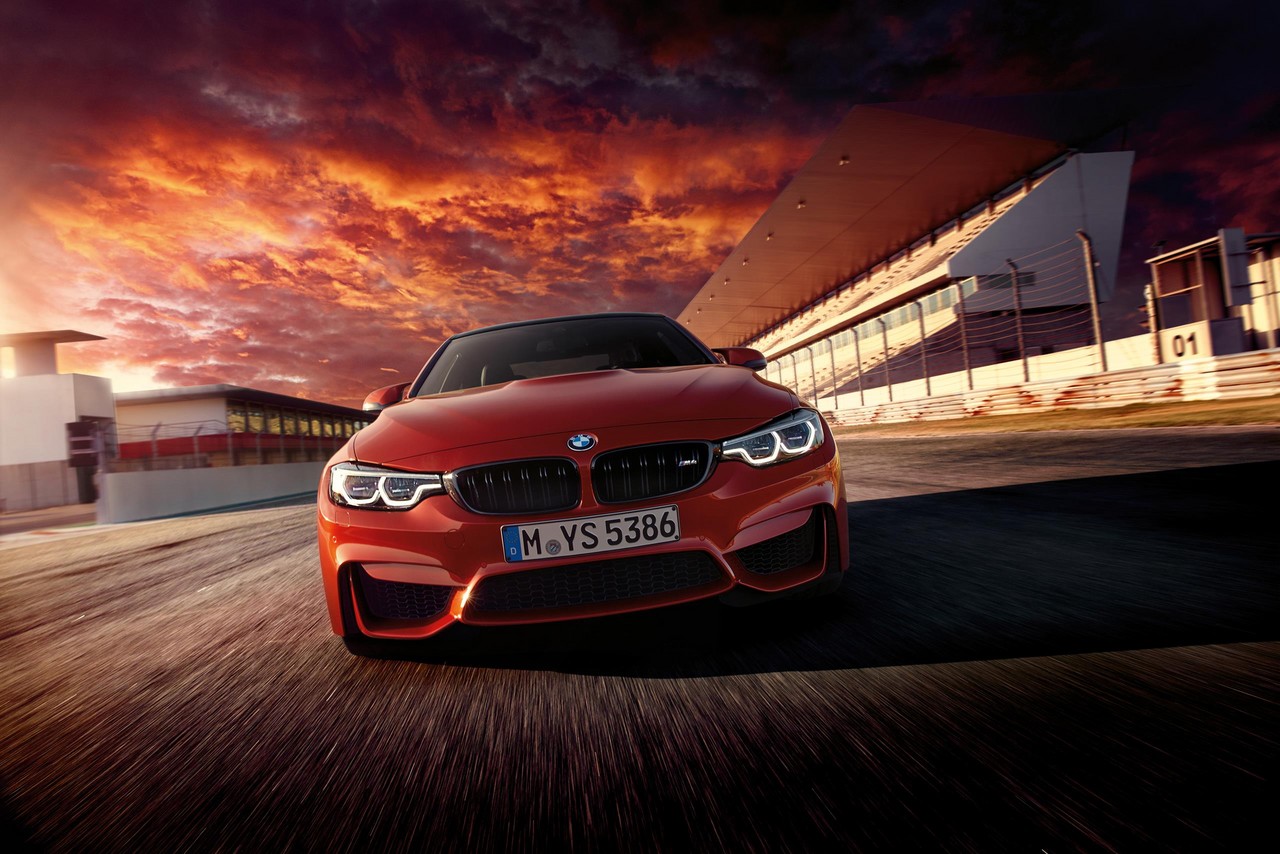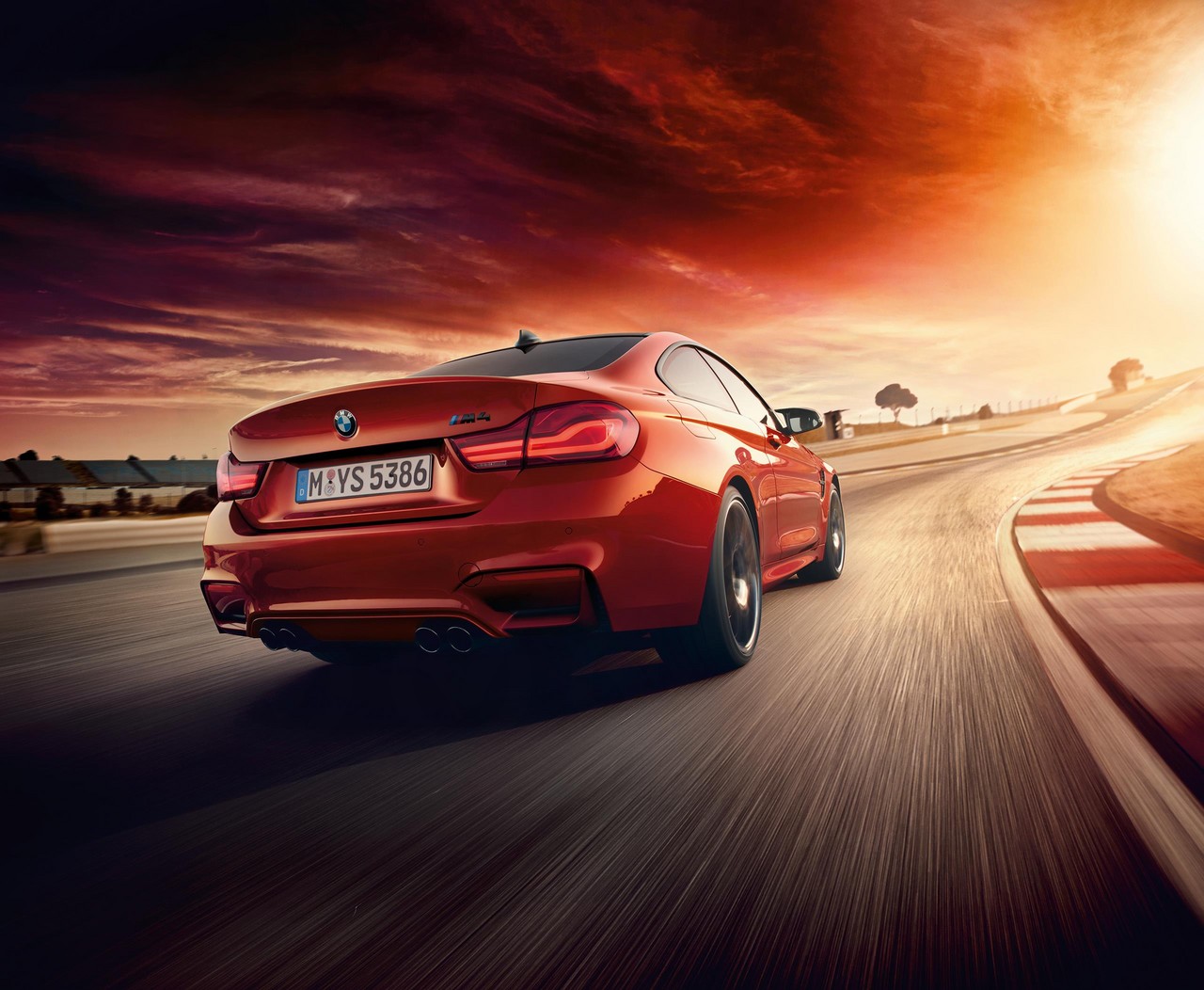
- Responsive and flexible 3.0-litre twin-turbo engine
- Balanced chassis and excellent dynamics
- Adaptive suspension provides range of settings
- Steering lacks feel
- Artificial engine note
- Intrusive tyre noise
Review: BMW F82 M4 Coupe (2014-17)
Overview
Released in Australia in June 2014, the BMW F82 M4 was a high-performance coupe (the F83 M4 Convertible has been reviewed separately). Manufactured in Munich, Germany, the F82 M4 Coupe was powered by BMW’s turbocharged 3.0-litre S55B30 six cylinder engine which was mated to either a six-speed manual transmission (with throttle blipping) or a seven-speed double clutch transmission (DCT).
S55B30 Engine
The S55B30 engine had a die-cast aluminium alloy block, a closed-deck crankcase, an aluminium cylinder head, a forged steel alloy crankshaft, double overhead camshafts, four valves per cylinder, two parallel Mitsubishi TF035 turbochargers which provided maximum boost pressure of 1.3 bar (18.85 psi), variable intake and exhaust camshaft timing (BMW’s ‘double VANOS’), variable intake valve timing (‘Valvetronic III’) and a compression ratio of 10.2:1. Maximum engine speed for the S55B30 engine was 7600 rpm.
To minimise fuel consumption, the S55B30 engine had a ‘Start Stop’ function which enabled it to shut down when the vehicle was stationary and BMW’s ‘Brake Energy Regeneration’ which varied alternator output when the vehicle was coasting or braking to recharge the battery. With the DCT, fuel consumption for the M4 Coupe was 8.3 litres per 100 km over the combined ECE 93/116/EU driving cycle.
| Engine | Trans. | Peak power | Peak torque | |
|---|---|---|---|---|
| M4 Coupe | 3.0-litre S55B30 twin-turbo petrol I6 | 6sp man., 7sp DCT |
317 kW at 5500-7300 rpm | 550 Nm at 1850-5500 rpm |
| M4 Coupe Competition Package | 3.0-litre S55B30 twin-turbo petrol I6 | 6sp man., 7sp DCT |
331 kW at 7000 rpm | 550 Nm at 1850-5500 rpm |
| M4 DTM Champion Edition | 3.0-litre S55B30 twin-turbo petrol I6 | 7sp DCT | 368 kW at 6250 rpm | 600 Nm at 4000 rpm |
Manual and M double clutch transmissions
The six-speed manual transmission had a double-plate clutch and carbon friction linings in its synchronizer rings. Previously reserved for BMW’s double clutch transmission, the manual transmission would blip the throttle on downshifts for smoother shifts and greater stability. Furthermore, the manual transmission was 12 kg lighter than its predecessor in the E92 M3 . Gear ratios for the manual transmission were 4.110 (1st), 2.315 (2nd), 1.542 (3rd), 1.179 (4th), 1.000 (5th) and 0.846; the final drive ratio for the manual transmission was 3.462.
The double clutch transmission (DCT) combined two gearbox components in a common housing and featured two oil-cooled wet clutches. One of the clutches operated the even gears (i.e. 2, 4 and 6), while the other clutch operated the uneven gears (i.e. 1, 3, 5, 7 and reverse). When driving, one of the clutches was always closed and the other open. When up- or down-shifting, the transmission control unit would pre-select the next gear and the clutches would be activated in an alternating process such that one clutch would open just as the other was closing.
The DCT had automated and manual gearshift modes with selectable shift settings; in manual mode, gear selection could be performed via the gear lever or steering wheel gearshift paddles. Gear ratios for the DCT were 4.806 (1st), 2.583 (2nd), 1.701 (3rd), 1.277 (4th), 1.000 (5th), 0.844 (6th) and 0.671 (7th); the final drive ratio for the DCT was 3.462.
When fitted with the seven-speed DCT and using the Launch Control function, the F82 M4 could accelerate from rest to 100 km/h in 4.1 seconds. The DCT also featured:
- A ‘Smokey Burnout’ function permitted a degree of rear wheel spin while the car was moving at low speeds; and,
- A Stability Clutch Control function that would ‘open the clutch when the car was understeering to bring it back into line’.
Dimensions and body
Compared to the E92 M3 Coupe which preceded it, the F82 M4 Coupe was 56 mm longer (at 4671 mm), 66 mm wider (1870 mm), 41 mm lower (1383 mm) and had a 60 mm longer wheelbase. Furthermore, boot space was 445 litres and the F82 M4 had a drag coefficient of 0.34 Cd.
The F82 M4 was around 80 kg lighter than its E92 predecessor, and mass reduction measures included:
- Aluminium suspension components (see ‘Suspension’, below);
- An aluminium bonnet;
- A carbon fibre-reinforced plastic (CFRP) roof which saved 5 kg (previously limited to the M4 Coupe); and,
- A CFRP driveshaft that was constructed as a single piece – without a centre bearing – and was 40 per cent lighter than its predecessor.
The F82 M4 had an unladen weight (EU) of 1537 kg for models with the manual transmission and 1612 kg with the DCT.
Suspension
The F82 M4 had double-joint spring strut front suspension and five-link rear suspension. The suspension also included electronically-controlled dampers (BMW’s ‘Adaptive M suspension’) continually adjusted to driving conditions and behavior, and enabled the driver to select from ‘Comfort’, ‘Sport’ and ‘Sport+’ settings via BMW’s ‘Driver Experience Control’.
For the front axle, aluminium was used for the control arms, wheel carriers and axle subframes for a 5 kg mass reduction relative to a conventional steel design. The suspension also included play-free ball joints and elastomer bearings (developed specifically for the F80 M3 Sedan , F82 M4 Coupe and F83 M4 Convertible ), an aluminium stiffening plate, CFRP precision strut and additional bolted joints between the axle subframe and the body structure for greater front end rigidity.
For the rear axle, the control arms and wheel carriers were manufactured using forged aluminium, while there was a rigid connection (i.e. without elastic rubber elements) between the rear axle subframe and the body to improve wheel location and directional stability.
Steering
The F82 M4 had electric, power-assisted rack and pinion steering in which the degree of assistance varied according to vehicle speed. The driver could also select from ‘Comfort’, ‘Sport’ and ‘Sport+’ modes.
Safety equipment
Standard safety equipment for the M4 Coupe included dual front airbags, front side airbags, full-length curtain airbags, ABS, electronic brake force distribution, brake assist, electronic stability control (BMW’s ‘Dynamic Stability Control’ or DSC), traction control, cornering brake control and front seatbelts with pretensioners and load limiters. The Dynamic Stability Control system had an ‘M Dynamic Mode’ which permitted a higher degree of yaw and wheelspin before intervening.
The M4 Coupe was also fitted with BMW’s ‘Active Protection’ system which operated automatically at speeds above 18 km/h. If the front-mounted camera or radar detected an emergency braking manoeuvre or the onset of heavy understeer or oversteer, Active Protection prepared for a collision by retracting the front seatbelts and closing the side windows and sunroof. Following the initial impact, the system would apply the brakes for a further 1.5 seconds to reduce the likelihood of a second collision.
The M4 Coupe also had a permanent SIM card which provided BMW Teleservices and ‘Intelligent’ emergency call functions.
Brakes
The M4 had 380 mm front brake discs with four-piston calipers and 370 mm rear brake discs with two-piston calipers; both front and rear discs were inner-vented and perforated.
Features: M4 Coupe
Standard features for the M4 Coupe included 19-inch forged alloy rims (9.0J front and 10.0J rear) with 255/35 ZR19 92Y front and 275/35 ZR19 100Y rear tyres, a 500 watt harman/kardon surround sound system with twelve speakers, auxiliary inputs (3.5 mm/USB) and Bluetooth connectivity, BMW’s ‘Professional’ navigation system with an 8.8-inch colour screen, 20Gb hard-drive and iDrive touch controller, extended ‘Merino’ leather upholstery, dual-zone climate control air conditioning, BMW’s ‘Air Collar’ (neck heating), power adjustable and heated front ‘M’ sports seats (with driver’s seat memory settings), bi-xenon headlights, automatic headlights, rain-sensing wipers, front and rear parking sensors, a rear view camera, bird’s eye surround view function, through-loading rear seats with a 60:40 split, ‘M’ leather steering wheel, remote central locking, proximity key for keyless entry (BMW’s ‘Comfort Access’), power windows and mirrors, a height and reach adjustable steering wheel, electrochromatic rear-view and door mirrors, carbon fibre interior trim, illuminated vanity mirrors, ambient lighting, ‘M’ door sills, a trip computer and an immobiliser.
July 2015 update
In July 2015, standard safety equipment for the F82 M4 Coupe was extended to include:
- BMW’s ‘Driving Assistant’:
- Approach Control Warning: if the driver was rapidly approaching an obstacle ahead, the driver would receive a visual warning in the instrument cluster, followed by a warning tone. If the driver failed to respond, the brakes would be applied automatically with deceleration of up to 3 m/s2;
- Lane Departure Warning (LDW): operating at speeds above 70 km/h, a camera could scan the road up to 50 metres ahead and detect lane markings. If the driver unintentionally deviated from their lane, the driver would be alerted via steering wheel vibrations and a visual warning in the instrument cluster;
- Pedestrian Warning with Light Braking Function: used a camera to scan the road ahead when the vehicle was travelling at speeds between 10 km/h and 60 km/h. if a potential collision with a pedestrian was identified, the driver would receive a visual warning in the instrument cluster and an alert tone; simultaneously, the braking system would be primed for maximum response. If the driver failed to respond, medium-force braking would be automatically initiated – this would reduce the risk of collision and prompt the driver to react. Once the driver applied the brake pedal, maximum braking force would be applied; and,
- Lane Change Warning: used two radar sensors in the rear of the vehicle to monitor traffic in adjacent lanes with a range of up to 60 metres behind the vehicle. The Lane Change Warning would warn the driver of potentially dangerous situations by conveying warnings through the instrument panel, an LED icon on the door mirror and steering wheel vibrations.
As part of the July 2015 update, BMW’s ConnectedDrive Services and Apps were also introduced – this included BMW TeleServices which enabled service-related vehicle data to be automatically transmitted to the driver’s preferred service dealer and for vehicle diagnostics to be transmitted to the Roadside Assistance Centre for immediate assessment over the phone.
Furthermore, standard features for the F82 M4 Coupe were extended to include full Merino leather upholstery (including the instrument panel and glove compartment), adaptive LED headlights, Internet connectivity, BMW’s ConnectedDrive Freedom (which included internet-based services, remote services, real-time traffic information and concierge services), Internet connectivity, head-up display and tyre pressure monitoring.
Active M Differential
The F82 M4 was fitted with an electronically controlled, multi-plate limited-slip differential (BMW’s ‘Active M Differential’) that operated in conjunction with the electronic stability control system. As such, the degree of differential locking could range from 0 to 100 per cent to prevent wheelspin and improve traction. By way of example,
- When lifting off the throttle, the differential would open such that the lock-up effect was zero for precise turn-in; and,
- When accelerating out of a corner, lock-up would occur progressively – up to 100 per cent – for maximum traction.
BMW M4 Coupe Competition Package
The BMW F82 M4 with Competition Package was released in Australia in July 2016. Changes for the BMW M4 Competition Package included:
- A more powerful S55B30 engine which produced peak power of 331 kW;
- Forged, machine-polished 20-inch M alloy wheels with 666 M styling and mixed tyres (265/30 R20 front and 285/30 R20 rear);
- For the ‘Adaptive M’ suspension, new springs (15 per cent stiffer), dampers, anti-roll bars and bushings, and reconfigured driving modes (Comfort, Sport and Sport+);
- A revised ‘Active M’ differential; and,
- Revised electronic stability control settings.
The BMW M4 Competition Package could be identified by its ‘BMW Individual’ high-gloss Shadow Line exterior trim for the side window trim, window recess finishers, door mirror frames, kidney grille, side gills and model badge. Inside, the M4 Competition Package had M leather seats with cut-out elements to reduce mass, while the seatbelts featured woven BMW M stripes.
2016 BMW M4 DTM Champion Edition
Released in Australia in December 2016, the BMW M4 DTM Champion Edition commemorated Marco Wittman’s 2016 DTM championship. The BMW M4 DTM Champion Edition had a production run of 200 vehicles; of these, ten (10) were delivered to Australia. For Australia, the BMW M4 DTM Champion Edition had a list price of $295,000.
Like the BMW M4 GTS, the BMW M4 DTM Champion Edition had a water injection system which sprayed a water mist to reduce intake air temperatures for higher boost pressure and more aggressive ignition timing. Other changes for the M4 DTM Champion Edition included:
- Three-way adjustable M coilover suspension that had remote reservoirs;
- 19-inch star-spoke ‘666 M’ wheels finished with ‘Orbit Grey’ matt paint, 265/35 ZR19 front and 285/30 ZR20 rear Michelin Pilot Sport Cup 2 tyres;
- A titanium exhaust system that had four outlets;
- M Carbon Ceramic brakes; and,
- BMW’s ‘Race Package’ which consisted of a white-painted roll-over protection system, six-point harnesses and fire extinguisher.
The BMW M4 DTM Champion Edition could accelerate from rest to 100 km/h in 3.8 seconds.
Inside, the BMW M4 DTM Champion Edition had thin-shelled ‘M’ bucket seats with Alcantara and Merino leather upholstery, and extensive Alcantara interior trim which included the ‘M Sports’ steering wheel. Australian-delivered vehicles also had a commemorative plaque signed by Marco Wittman.
Visual cues for the BMW M4 DTM Champion Edition included its Alpine White paint finish, additional ‘M’ striping along the flanks and CFRP (carbon fibre reinforced plastic) roof, prominent CFRP for the fixed front splitter and aero elements, door mirror caps, side skirts, diffuser and fixed boot-mounted spoiler. Like the BMW M4 GTS, the bonnet was also produced from CFRP.
Related links
- Press Kit: BMW F80 M3 and F82 M4 (December 2013)
- Specifications: BMW F80 M3 and F82 M4 (May 2014)
- Specification Guide: BMW F80 M3, F82 M4 and F83 M4 (July 2016)
Review: BMW F82 LCI M4 Coupe (2017-20)
Overview
Commencing production in March 2017, the BMW F82 LCI M4 Coupe was released in Australia in June 2017. As part of the update, the range was expanded with the M4 Pure Coupe, which was fitted with BMW’s ‘Competition’ package as standard.
Visually, the F82 LCI M4 Coupe could be identified by the new design for the adaptive LED headlights which included LED indicators that formed a thin ‘eyebrow’ above the headlights; new L-shaped LED tail-lights were also introduced.
Inside, the BMW F82 LCI M4 Coupe introduced the iDrive6 infotainment system (which included BMW’s ‘Professional’ navigation system and an 8.8-inch colour touchscreen), new ‘M’ emblems for the front seats, electroplated detailing, chrome highlights and, for the M4 and M4 Competition, double stitching on the leather instrument panel. Changes were also made to the interior controls: the indicator stalks would ‘snap into place when engaged’ and the stalk-mounted buttons to activate the rain sensor and high-beam assist would stay depressed (rather than springing back to their original position) when engaged.
| Engine | Trans. | Peak power | Peak torque | |
|---|---|---|---|---|
| M4 Pure | 3.0-litre S55B30 twin-turbo petrol I6 | 6sp man., 7sp DCT |
331 kW at 7000 rpm | 550 Nm at 1850-5500 rpm |
| M4 Competition | 3.0-litre S55B30 twin-turbo petrol I6 | 6sp man., 7sp DCT |
331 kW at 7000 rpm | 550 Nm at 1850-5500 rpm |
| M4 CS | 3.0-litre S55B30 twin-turbo petrol I6 | 7sp DCT | 338 kW at 6250 rpm | 600 Nm at 4000-5380 rpm |
Features
For a complete list of features for the BMW F82 LCI M4 Coupe, please refer to the specifications document under ‘Related links’ (below).
November 2017 change: steel driveshaft
From November 2017 production, the carbon fibre reinforced plastic (CRFP) driveshaft for the BMW F82 LCI M4 was replaced by an ‘M specific’ high-performance steel driveshaft. According to BMW, the steel driveshaft provided ‘the necessary technical basis for meeting future statutory emissions requirements.’
In announcing this production change, BMW also indicated that a petrol particulate filter (PPF) would be incorporated into the ‘existing installation space’ for the F80 LCI M3, F82 LCI M4 Coupe and F83 LCI M4 Convertible ‘at a later point in time.’
BMW F82 M4 CS
The BMW F82 M4 CS was released in Australia in December 2017. A limited-run model, the BMW M4 CS could be identified by its exposed carbon fibre front splitter which reduced front axle lift and rear Gurney (an aerodynamic spoiler lip which extended across the trailing edge of the boot lid to reduce rear-axle lift). To reduce mass, the M4 CS had a CFRP bonnet and rear diffuser.
Inside, the BMW M4 CS featured combination leather/Alcantara seat upholstery, while Alcantara trim was used for the door armrests, passenger side dash trim and centre console. Like the BMW M4 GTS, the interior door panels and side trim in the rear compartment were made from compacted natural fibres that were then given ‘a special carbon-fibre look’. The BMW M4 CS also had M-striped door pull straps.
Related links
- Specifications: BMW F80 LCI M3, F82 LCI M4 Coupe and F83 LCI M4 Convertible (March 2017)
- BMW Australia: BMW M4 Coupe
- BMW Press: the BMW M4 CS (May 2017)
- Wikipedia.org: BMW F32 4-Series

